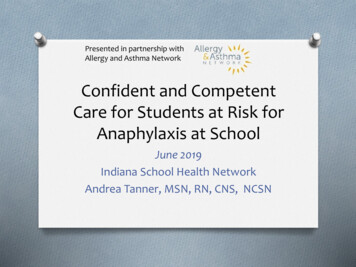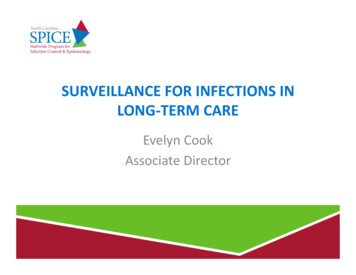
Transcription
Presented in partnership withAllergy and Asthma NetworkConfident and CompetentCare for Students at Risk forAnaphylaxis at SchoolJune 2019Indiana School Health NetworkAndrea Tanner, MSN, RN, CNS, NCSN
Presenter DisclosuresAndrea Tanner, MSN, RN, CNS, NCSNThe following personal financialrelationships with commercial interestsrelevant to this presentation existedduring the past 12 months:No relationships to disclose.
Objectives Identify the top eight food allergens and thesymptoms of anaphylaxis when these allergenscause a life-threatening allergic reaction. Discuss school safety strategies to practiceallergy exposure prevention strategies andrespond to an anaphylactic emergency whennecessary Identify educational needs of clinic and schoolstaff and review appropriate training tools.
Allergy 101
AnaphylaxisO Occurs in 1 in 50peopleO May be higherO May begin inseconds afterexposure, maybe hoursO Epinephrine First,EpinephrineFAST!
Top 8 Allergens
Kids say the darnedest things
5 Myths about Food AllergiesO Myth: Severe food allergy reactions can beOOOOtreated with antihistamines.Myth: Children younger than 3 years old can’tbe tested for food allergies.Myth: Parents should not introduce commonfood allergens into their child’s diet before age3.Myth: Children with egg allergy should not getthe flu shot or the MMR (measles, mumps,rubella) vaccine.Myth: Gluten is a food allergen and eliminatingit from my diet will help me feel better.
Is it a Food Allergy or FoodIntolerance?Lactose Intolerance or Milk Allergy?!?Food IntoleranceFood AllergyWhere reaction takes placeDigestive SystemImmune systemIntensity of reactionMild to moderate discomfortCan be life-threateningSymptomsGastrointestinalMultiple body systems: skin,respiratory, heart and/orgastrointestinalReaction timeMay be delayedUsually immediate (within 30– 60 minutes)Action to takeSee healthcare providerCall 911 if anaphylaxis occursNeed a diagnosis!
Is it Oral Allergy Syndrome?Contact allergic reactionthat occurs upon contactof the mouth and throatwith raw fruits orvegetables.Apples/Pears BirchCantaloupe/Honeydew RagweedOrange/Tomato Timothy and Orchard GrassBell Peppers/Broccoli Mugwort
Insect Venom AllergiesO What to do if stungO Flick the insect away from your skin.O Walk (don’t run) away from the area. Someinsects will be threatened by quick movementsand running may increase your body’sabsorption of the venom.O If a stinger is left in the skin (the telltale mark ofa honeybee), scrape it off with a flat surface, likea credit card; do not use tweezers or yourfingertips, as that could squeeze more venominto the sting area.
Insect Sting AllergiesO Apply ice to reduce swelling.O Expect local redness and swelling.O Watch for these symptoms indicating an anaphylacticreaction:O – Hives or generalized itching other than at the site ofthe stingO – Swelling of the throat or tongueO – Difficulty breathingO – DizzinessO – Severe headacheO – Stomach cramps, nausea ordiarrheaO These symptoms indicate need for immediatetreatment with an epinephrine auto-injector, followedby medical assistance at an emergency facility.
Latex AllergyO Reaction to proteinsO Symptoms range fromfrom the Heveabrasiliensis rubbertree sap, the milkyfluid used tomanufacture morethan 40,000products, includingsurgical gloves andhelium balloons.skin irritation torespiratory symptomsto life-threateninganaphylaxis – andthere’s no way topredict which willoccur if exposed.O Strict avoidance is onlyway to prevent areaction.
Latex AllergyCommon AllergensCross-Reactive FoodsO Latex balloonsO AppleO Rubber glovesO AvocadoO Rubber bandsO BananaO StethoscopesO CarrotO Blood pressure cuffsO CeleryO Mouse padsO ChestnutO GogglesO KiwiMelonsPapayaPotatoTomato
Additional Types of AllergiesO UnknownO MedicationO Exercise
Developmental SkillsO Early elementary:O Learn to trust &communicate withcaregiversO Upper elementary:O Recognizesymptoms, requestor use medsO Middle school:O Develop medicationroutineO Teens:O Take responsibilityfor daily meds(supervised byparents)O Older teens:O Demonstrate abilityto complete selfcare & healthcareappointments
School SafetyGuidance forAllergyManagement
4 Components of AllergyManagement at SchoolPlanning & Coordination ofCare② Educating Staff, Students &Parents③ Providing a Safe Environment④ Prompt Emergency Response①
Education of School StaffO EmergencyresponseO Federal lawsO ADAO Section 504O FERPAO State lawsO RegulationsO District policiesO EpinephrineadministrationO DelegationO Encourage self-managementO Effects behavior andability to learn
Education of School StaffO Emotional supportO Children with foodallergiesO Children who mightwitness a severe foodallergy reactionO Common risk factors,triggers, and areas ofexposure to foodallergens in schoolsO Fully integrate children withallergies into school and classactivitiesO Reduce risk of exposure toallergens in classrooms and:O During mealsO During nonacademicoutings, field tripsO During official activitiesbefore and after schoolprogramsO During events sponsoredby schools programs thatare held outside ofregular hours.
Does Peanut-Free EqualCertainty?
Peanut-free schools hadhigher rates ofepinephrineadministration comparedto non-peanut-free.O Schools with peanut-free tableshad lower rates of epinephrineadministration compared toschools without peanut-freetables.O Elementary schools withpeanut-free classrooms hadlower rates of epinephrineadministration compared toschools without des/files/DPH Updates 2 13 14.pdf
Student Healthcare PlansO IndividualizedHealthcare Plan(IHP)O Emergency Actionor Care Plan (ECP)O AAP PlanO IndividualizedEducation Plan (IEP)O Section 504 Plan(NASN, 2017)
https://www.aap.org/enus/Documents/AAP Allergy and Anaphylaxis Emergency Plan.pdf
Emergency ProceduresO Epinephrine first, Epinephrine FASTO Staff considerationsO Policies & Protocols– NASN resourceO Epinephrine storageO Expiration issuesO Calling an ambulanceO Staff should know how!
o-epinephrine-map
Table Top DrillsO School Staff meets to discuss an emergencyresponse to an episode of anaphylaxisO Led by the school nurseO 3 scenarios availableO Elementary – food allergyO Middle school – latex allergyO High school – venom allergyO Notes provided
Example: ElementaryO Olivia, a 2nd grade studentbegins coughing in theclassroom. The teacher notesthere is some swelling aroundOlivia’s eyes and lips.O The teacher keeps Olivia calmand calls the school nurse.Olivia begins to wheeze andstarts grabbing her neck. Sheis gasping for air and cannotspeak.O What do you see?What signs &symptoms ofanaphylaxis arepresent?O What do you dofirst?O What steps shouldyou follow next?
Questions for ConsiderationO Is there an Emergency Care Plan for this student? If so,always initiate the plan immediately.O Reactions happen away from the school health office -Who is trained in your school to respond to an allergicemergency?O How is your school prepared for responding tostudents who exhibit signs and symptoms ofanaphylaxis but have no previously known allergy?O Is epinephrine immediately available?O Do you have stock epinephrine?O Where is the student’s epinephrine stored?O Who in your school can administer epinephrine?
School Staff Roles in an AnaphylaxisEmergencyMore information on school staff roles can be found in the CDC’s“Voluntary Guidelines for Managing Food Allergies in Schools and EarlyCare and Education Programs”O School nurse orOOOOdesigneeSchoolAdministratorTeacherSchool Counselor /Mental Health StaffSchool SecretaryAdjust roles asappropriate to yourschool’s unique staffingpattern and schoollayout.
EducationalResources forStudent & StaffInstruction
What Staff Should KnowO How to Use an Epinephrine Auto-InjectorO Epinephrine or Antihistamine?O How to Read a Food Label
Prevention Reading Labels FDA requires all packaged food to list the eightmajor food allergens in plain (clear andunderstandable) language. Major 8 Allergens: Milk, Egg, Fish, CrustaceanShellfish, Peanuts, Tree Nuts (walnut, almond,hazelnut, cashew, pistachio, and Brazil nuts) ,Wheat, and Soy. These allergens account forover 90 percent of all food allergies in the U.S. These allergens must be stated if found inflavorings, colorings, or other additives.
Prevention Reading Labels
Posters for Schools
Resources for TrainingO American Academyof PediatricsO Clinical Report(Wang & Sicherer, 2017)O AllergyHome.orgO School stafftraining moduleO Certificate availableO FAMEO St. Louis Children’sHospitalO Content for wholeschool community
Allergy & Anaphylaxis: APractical Guide for Schools andFamiliesO Available for a FREE download at:Allergyasthmanetwork.org –Healthcare Professionals – Outreach– Publications – Special Publications
Questions?Resources at www.allergyasthmanetwork.org
Student Healthcare Plans O Individualized Healthcare Plan (IHP) O Emergency Action or Care Plan (ECP) O AAP Plan O Individualized . O Led by the school nurse O 3 scenarios available O Elementary -food allergy . O Available for a FREE download at:











